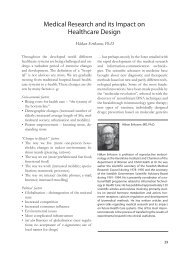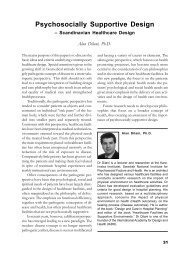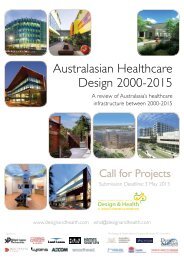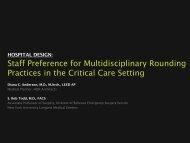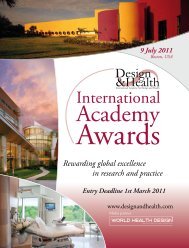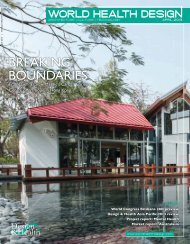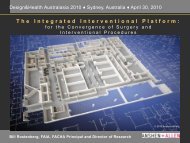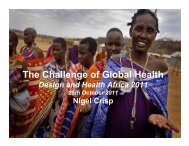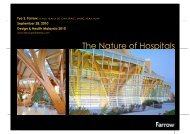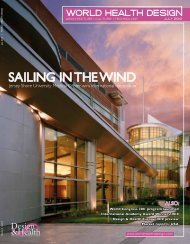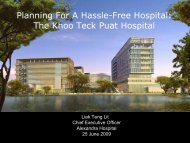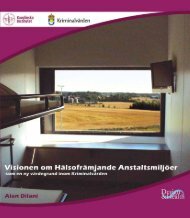SUPER GREEN - the International Academy of Design and Health
SUPER GREEN - the International Academy of Design and Health
SUPER GREEN - the International Academy of Design and Health
- No tags were found...
Create successful ePaper yourself
Turn your PDF publications into a flip-book with our unique Google optimized e-Paper software.
<strong>Design</strong> & <strong>Health</strong> Scientifi c ReviewAwakeningsDr John Zeisel is chair <strong>of</strong> <strong>the</strong>international advisory board<strong>of</strong> <strong>the</strong> <strong>International</strong> <strong>Academy</strong>for <strong>Design</strong> & <strong>Health</strong> <strong>and</strong>president <strong>of</strong> HearthstoneAlzheimer CarePr<strong>of</strong> Romano Del Nordis chair <strong>of</strong> <strong>the</strong> scientifi ccommittee <strong>of</strong> <strong>the</strong> <strong>International</strong><strong>Academy</strong> for <strong>Design</strong> & <strong>Health</strong><strong>and</strong> deputy rector <strong>of</strong> <strong>the</strong>University <strong>of</strong> FlorenceIn our daily lives we are <strong>of</strong>ten so busy <strong>and</strong> preoccupiedthat we don’t see obvious every day things in front <strong>of</strong> oureyes. We pass a particular store <strong>and</strong> don’t notice <strong>the</strong> shopwindow has been changed, <strong>and</strong> we sit in our favourite chairwithout noticing that it has been cleaned for <strong>the</strong> fi rst timein years. These things pass unnoticed – until someone points<strong>the</strong>m out!That’s what evidenced-basedresearch in <strong>the</strong> built environmentcan do for us, as is <strong>the</strong> case withthis issue’s articles. Shopping in acrowded street market, womenhaving babies, <strong>and</strong> looking out awindow at an ocean view are some <strong>of</strong> <strong>the</strong> every day events in which <strong>the</strong>built environment can impact on our health <strong>and</strong> wellbeing.Akers <strong>and</strong> Akers’ careful multi-method study <strong>of</strong> <strong>the</strong> health implications<strong>of</strong> selling vegetables <strong>and</strong> o<strong>the</strong>r household goods on crowded sidewalksin Baguio City, Philippines makes us take a second glance at all those whowork outdoors in crowded cities. It is now de rigueur in New York City tohave a gyro s<strong>and</strong>wich <strong>and</strong> fruit shake on <strong>the</strong> corner for lunch. In Bangkok,food <strong>and</strong> knock-<strong>of</strong>f clothing vendors line every downtown sidewalk.This study also demonstrates how important it is to analyse environmentscarefully when drawing conclusions – <strong>the</strong> width <strong>of</strong> <strong>the</strong> sidewalk <strong>and</strong> <strong>the</strong>slope <strong>of</strong> <strong>the</strong> street in this example – <strong>and</strong> to employ <strong>the</strong> most appropriatemethod for each dimension.Forbes, Homer, Foureur <strong>and</strong> Leap carry out a similarly careful study <strong>of</strong>places for birthing. If birthing at home is so much more comfortable <strong>and</strong>natural, <strong>the</strong>y posit, we ought to design hospital environments for birthing thathave <strong>the</strong> same supportive characteristics. Their design recommendationsinclude such subtle elements as <strong>the</strong> fl ow rate <strong>of</strong> bath water so that <strong>the</strong>water can be heated up quickly for comfort, <strong>and</strong> location <strong>of</strong> <strong>the</strong> bath againsta wall so that mo<strong>the</strong>rs feel less “on display”.Jones <strong>and</strong> Manighetti, in part <strong>of</strong> <strong>the</strong>ir research, examine <strong>the</strong> every dayaction <strong>of</strong> looking out <strong>of</strong> an <strong>of</strong>fi ce window – something we do many times aday. But are we aware <strong>of</strong> what we are looking at, how one view differs fromano<strong>the</strong>r, <strong>and</strong> how that view affects our wellbeing? I seldom am!Their fi nal hypo<strong>the</strong>sis focuses on what it is that makes views <strong>of</strong> natureso engaging <strong>and</strong> health promoting. What <strong>the</strong>y conclude is that it may wellbe <strong>the</strong> colours – is it “nature” that makes us feel better or <strong>the</strong> colours blue<strong>and</strong> green?All in all, evidence-based design research does more than just giveus design guidelines; it helps us wake up to our surroundings. For thisI am thankful.47-53Birthing unit design:Researching new principlesIan Forbes MSc, (<strong>Health</strong>Services Planning <strong>and</strong> Administration), Grad Dip BusAdmin, BArch, FRAIA; Caroline Homer, RM RN MN, PhD;Maralyn Foureur, RM, RN, BA, Grad Dip Clin Epidem &Biostats, PhD; Nicky Leap, DMid MSc RM55-59Urban design:The health impact <strong>of</strong> street vendorenvironmentsMary Anne Alabanza Akers, PhD; Timothy A Akers, PhD63-67Environmental psychology:The impact <strong>of</strong> colour <strong>and</strong> light on wellbeingLinda Jones PhD; Barbara Manighetti PhDWORLD HEALTH DESIGN | October 2008 45



